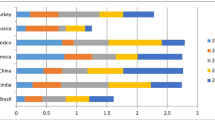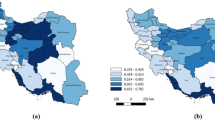Abstract
Data envelopment analysis as a nonparametric frontier approach has gained increasing popularity in assessing total factor energy efficiency performance. Earlier studies often assume that production activity lies in the economic area, and energy inefficiency associated with energy congestion has seldom been examined. This paper contributes to energy efficiency assessment by developing a decomposition model to examine the energy inefficiency driven by energy congestion and empirically examining whether the energy use in Chinese industrial sectors shows evidence of congestion. It is found that energy congestion does exist in Chinese industrial sectors but varies across different provinces. The provinces with high energy intensities are more likely to suffer from energy congestion. Our empirical results also show that energy congestion could be a main driving force of energy inefficiency. Some policy implications towards energy conservation in China are finally discussed.




Similar content being viewed by others
Notes
In neoclassical economics, the economic area means the area surrounded by the ridge lines, while the non-economic area indicates the area outside the ridge lines where the marginal output of some input becomes negative and the substitution between the factors becomes impossible. It is true that in practise, profit-oriented producers seldom operate their production in the non-economic area. However, Rødseth (2013) has revealed that input congestion might occur at the industry level even if it is often absent at the firm level, which highlights the economically importance of investigating input congestion in the industrial sectors.
Conventionally, non-energy input is treated as a fixed factor on which energy input causes congestion. In real industrial production process, it might be difficult to observe the phenomenon of energy congestion since with the increasing of energy input the non-energy inputs are normally increased as well. As a result, the negative marginal product of energy input would be offset by the positive marginal product of the non-energy input and the output could not decline.
Input congestion indicates that the production frontier bends back. The non-parametric DEA method which requires neither priori weights nor explicit specification of functional form among inputs and outputs has gained popularity in congestion measurement due to its strength in depicting the back-bending frontier.
The 17 types of fuels include raw coal, cleaned coal, other washed coal, briquettes, coke, coke oven gas, other gas, crude oil, gasoline, kerosene, diesel oil, fuel oil, liquefied petroleum gas, refinery gas, natural gas, heat and electricity.
The east area includes Beijing, Tianjin, Hebei, Liaoning, Shanghai, Jiangsu, Zhejiang, Fujian, Shandong, Guangdong, and Hainan; the central area includes Shanxi, Jilin, Heilongjiang, Anhui, Jiangxi, Henan, Hubei, and Hunan; the west area includes Inner Mongolia, Guangxi, Sichuan, Guizhou, Yunnan, Shaanxi, Gansu, Qinghai, Ningxia and Xinjiang.
References
Ang, B. W., Mu, A. R., & Zhou, P. (2010). Accounting frameworks for tracking energy efficiency trends. Energy Economics, 32, 1209–1219.
Boyd, G. A. (2008). Estimating plant level energy efficiency with a stochastic frontier. The Energy Journal, 29(2), 23–43.
Boyd, G., & Zhang, G. (2013). Measuring improvement in energy efficiency of the US cement industry with the ENERGY STAR energy performance indicator. Energy Efficiency, 6, 105–116.
Brockett, P. L., Cooper, W. W., & Wang, Y. Y. (1998). Inefficiency and congestion in Chinese production before and after the 1978 economic reforms. Socio-Economic Planning Sciences, 32, 1–20.
Cherchye, L., Kuosmanen, T., & Post, T. (2001). Alternative treatment of congestion in DEA: a rejoinder to cooper, Gu, and Li. European Journal of Operational Research, 132, 75–80.
Cooper, W. W., Thompson, R. G., & Thrall, R. M. (1996). Introduction: extensions and new developments in DEA. Annals of Operations Research, 66, 3–45.
Cooper, W. W., Deng, H. H., Gu, B. S., Li, S. L., & Thrall, R. M. (2001). Using DEA to improve the management of congestion in Chinese industries (1981–1997). Socio-Economic Planning Sciences, 35, 227–242.
Färe, R., & Grosskopf, S. (1983). Measuring congestion in production. Zeitschrift für Nationalökonomie, 43, 257–271.
Färe, R., Grosskopf, S., & Lovell, C. A. K. (1985). The measurement of efficiency of production. Boston, MA:Kluwer Nijhoff Publishing.
Farrell, M. J. (1957). The measurement of productive efficiency. Journal of Royal Statistics Society, Series A, 120(3), 253–290.
Filippini, M., & Hunt, L. C. (2011). Energy demand and energy efficiency in the OECD countries: a stochastic demand frontier approach. The Energy Journal, 32(2), 59–80.
Filippini, M., & Hunt, L. C. (2012). US residential energy demand and energy efficiency: a stochastic demand frontier approach. Energy Economics, 34, 1484–1491.
Flegg, A. T., & Allen, D. O. (2009). Congestion in the Chinese automobile and textile industries revisited. Socio-Economic Planning Sciences, 43, 177–192.
Goto, M., Otsuka, A., & Sueyoshi, T. (2014). DEA assessment of operational and environmental efficiencies on Japanese regional industries. Energy, 66, 535–549.
Hasanbeigi, A., Pricea, L., Zhang, C. X., Adena, N., Li, X. P., & Shangguan, F. Q. (2014). Comparison of iron and steel production energy use and energy intensity in China and the U.S. Journal of Cleaner Production, 65, 108–119.
Hu, J. L., & Wang, S. C. (2006). Total-factor energy efficiency of regions in china. Energy Policy, 34(17), 3206–3217.
Kao, C. (2010). Congestion measurement and elimination under the framework of data envelopment analysis. International Journal of Production Economics, 123, 257–265.
Kopsakangas-Savolainen, M., & Svento, R. (2008). Estimation of cost-effectiveness of the Finnish electricity distribution utilities. Energy Economics, 30, 212–229.
Kopsakangas-Savolainen, M., & Svento, R. (2011). Observed and unobserved heterogeneity in stochastic frontier models: an application to the electricity distribution industry. Energy Economics, 33, 304–310.
Kuosmanen, T. (2012). Stochastic semi-nonparametric frontier estimation of electricity distribution. Energy Economics, 34(6), 2189–2199.
Kuosmanen, T., & Kortelainen, M. (2012). Stochastic non-smooth envelopment of data: semi-parametric frontier estimation subject to shape constraints. Journal of Productivity Analysis, 38(1), 11–28.
Lin, B. Q., & Wang, X. L. (2014). Exploring energy efficiency in China’s iron and steel industry: a stochastic frontier approach. Energy Policy, 72, 87–96.
Mandal, S. K., & Madheswaran, S. (2011). Energy use efficiency of Indian cement companies: a data envelopment analysis. Energy Efficiency, 4, 57–73.
Morfeldt, J., & Silveira, S. (2014). Capturing energy efficiency in european iron and steel production – comparing specific energy consumption and malmquist productivity index. Energy Efficiency, 7, 955–972.
National Bureau of Statistics of China (NBSC) (2014). China statistical yearbook 2014. Beijing:China Statistical Press.
Pardo Martínez, C. I. (2011). Energy efficiency development in German and Colombian non-energy-intensive sectors: a non-parametric analysis. Energy Efficiency, 4, 115–131.
Ray, S. C. (2004). Data envelopment analysis: theory and techniques for economics and operations research. Cambridge:Cambridge University Press.
Rødseth, K. L. (2013). A note on input congestion. Economics Letters, 120, 599–602.
Sueyoshi, T., & Sekitani, K. (2009). DEA congestion and returns to scale under an occurrence of multiple optimal projections. European Journal of Operational Research, 194, 592–607.
Tone, K., & Sahoo, B. K. (2004). Degree of scale economies and congestion: a unified DEA approach. European Journal of Operational Research, 158, 755–772.
Wang, Q. W., Zhao, Z. Y., Zhou, P., & Zhou, D. Q. (2013). Energy efficiency and production technology heterogeneity in China: a meta-frontier DEA approach. Economic Modelling, 35, 283–289.
Wei, Y. M., Liao, H., & Fan, Y. (2007). An empirical analysis of energy efficiency in China’s iron and steel sector. Energy, 32(12), 2262–2270.
Wu, F., Fan, L. W., Zhou, P., & Zhou, D. Q. (2012). Industrial energy efficiency with CO2 emissions in China: a nonparametric analysis. Energy Policy, 49, 164–172.
Wu, J., An, Q. X., Xiong, B. B., & Chen, Y. (2013). Congestion measurement for regional industries in China: a data envelopment analysis approach with undesirable outputs. Energy Policy, 57, 7–13.
Yang, M., Patiño-Echeverri, D., Yang, F., & Williams, E. (2015). Industrial energy efficiency in China: achievements, challenges and opportunities. Energy Strategy Reviews, 6, 20–29.
Zhou, P., & Ang, B. W. (2008). Linear programming models for measuring economy-wide energy efficiency performance. Energy Policy, 36, 2911–2916.
Zhou, P., Ang, B. W., & Han, J. Y. (2010). Total-factor carbon emission performance: a malmquist index analysis. Energy Economics, 32, 194–201.
Zhou, P., Ang, B. W., & Zhou, D. Q. (2012). Measuring economy-wide energy efficiency performance: a parametric frontier approach. Applied Energy, 90, 196–200.
Acknowledgments
The authors are grateful to the financial support provided by the National Natural Science Foundation of China (no. 71273005), the Jiangsu Natural Science Foundation for Distinguished Young Scholar (no. BK20140038), the Humanities and Social Science Foundation of the Ministry of Education (no. 12YJCZH039), the Funding of Jiangsu Innovation Program for Graduate Education (CXLX13_170), and the NUAA research funding (no. NE2013104).
Author information
Authors and Affiliations
Corresponding author
Rights and permissions
About this article
Cite this article
Wu, F., Zhou, P. & Zhou, D.Q. Does there exist energy congestion? Empirical evidence from Chinese industrial sectors. Energy Efficiency 9, 371–384 (2016). https://doi.org/10.1007/s12053-015-9370-2
Received:
Accepted:
Published:
Issue Date:
DOI: https://doi.org/10.1007/s12053-015-9370-2




